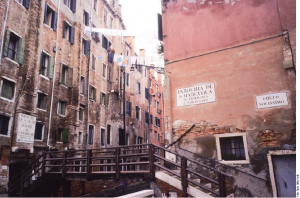VENICE AND THE GHETTO “Reflecting on Segregation Helps Us Understand the Present”
By Gadi Luzzatto Voghera*
In the struggle to clarify any misunderstanding — the ones inattentive tourists often run into while they wander the calli and campi of Venice — it’s important to underline that the Ghetto of Venice is not the first ghetto to have ever been built, and it also has nothing to do with those established by Nazis.
The first assertion may provoke a scandal (especially in the context of the manifestations for the 500 years of the Ghetto in Venice) although it is the truth. At most we could state that the Venetian Ghetto was the first place where Jews had to forcefully reside to be called this way, albeit detached Jewish districts already existed prior to 1516: Judengasse, Giudecche, Juderías, sometimes with a set of rules very similar to the one adopted by the Republic of Venice. So, we could say that this definition works.
Shifting the attention to Nazis, it would be truly necessary to follow the path of collective cultivation: Hitler and his followers consciously took advantage of what we could call a historic “brand” in order to spread a specific message that, unfortunately, keeps being incisive. According to him, Jews, at least at first, could live in ghettos, wearing their yellow stars and staying away from the rest of the population. Sadly, the collective imagination — also influenced by some films and a wide-spread disinterest in historical events — makes most of the tourists in Venice believe that “every Jew lived in the ghetto and ghettos were created by Nazism.” Well, it’s not the case. Louis Wirth, one of the fathers of sociology, in his work The Ghetto (Transaction Publisher, 1998) maintains that in modern times the term ghetto can mean either a social form linked to migrations (little Italy, China etc. in the U.S.A., the so-called ethnic districts) and a stable form of political supremacy and expression of a racial prejudice typically found in the history of Europe.
Reflecting on the concept of ghetto is still actual: the migratory phenomena, to which our societies are used to by now but are unable to provide convincing and effective solutions, and the re-emerging of racial prejudices and tensions, that should have been hopefully buried and condemned by the experience of WWII, make this theme one of the fundamental places of remembrance nowadays. The sociological consideration also includes other types of ghettoization that can be connected to historical contexts first identified in Venice. This is why the idea of ghetto may include the one of leper hospitals, the historical predecessors of current hospitals, but also a place of forced segregation caused by suspicious and unknowable illnesses that needed to be separated from the community. Asylums have similar characteristics: they’re places established on the rule of exclusion to preserve society from an unacceptable and misunderstood minority. But also internment camps, a more brutal version of the traditional prison, barracks and — why not? — brothels.
Shifting our attention to the great extra-European urban centres, why not consider as an example of segregation southern American Favelas, or even the ethnical districts in which black people are segregated in the American metropolis? Or even, in a positive sense, those phenomena of self-segregation typical of juvenile groups who take pride in defining their own independent space as “ghetto”, a place in which leading an alternative life far from the model imposed by the capitalist consumerism. In this case, these are all places of segregation that deduced their functional models from the ghetto experience and that were able to spread out at every latitude in every era, without any sign of faltering. This is why, from a sociological perspective, the year 1797, when the doors of the venetian Ghetto were demolished, represents just one chapter of a story that’s still told today and doesn’t seem end any time soon.
*Gadi Luzzatto Voghera is an historian. This article has been translated by Letizia Anelli, student at the Scuola superiore interpreti e traduttori di Trieste, who is doing her apprenticeship in the newsroom of Pagine Ebraiche.

